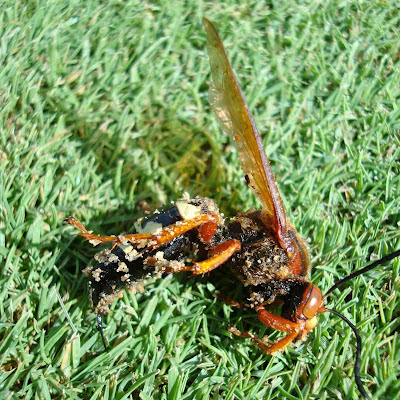Some areas in the rough are beginning to show evidence of grub worms feeding on the roots of the plant. Greens, tees, fairways and the rough around the fairways is treated to prevent damage. Most of the rough is not treated due to it being cost prohibitive to make an application across all of the rough. The brown spots (in the picture) around healthy green grass is a typical sign of grubs feeding.
These grubs will feed on the roots this fall before burrowing deeper into the ground when cooler weather sets in. They will overwinter in the ground as grubs. As temperatures warm in the spring, they will return to the surface and prepare for their pupation stage before emerging from the ground as adults in June and July. They mate, and lay eggs which hatch and begin to feed on the roots in August and start the cycle over again.
The worst of the areas is by the red tee on 13. Though the roots are damaged, the majority of this disruption was caused by a skunk or raccoon scraping the turf while preying on the grubs. The areas that we have found have been treated with a product that will kill the grubs. We suspect more areas to show as the days go on. We will continue these applications as new areas are scouted. Most of the damaged areas will come back after the grubs stop feeding. This spot at 13 red tee will require some seed this fall for a full recovery.
These grubs will feed on the roots this fall before burrowing deeper into the ground when cooler weather sets in. They will overwinter in the ground as grubs. As temperatures warm in the spring, they will return to the surface and prepare for their pupation stage before emerging from the ground as adults in June and July. They mate, and lay eggs which hatch and begin to feed on the roots in August and start the cycle over again.
The worst of the areas is by the red tee on 13. Though the roots are damaged, the majority of this disruption was caused by a skunk or raccoon scraping the turf while preying on the grubs. The areas that we have found have been treated with a product that will kill the grubs. We suspect more areas to show as the days go on. We will continue these applications as new areas are scouted. Most of the damaged areas will come back after the grubs stop feeding. This spot at 13 red tee will require some seed this fall for a full recovery.




















